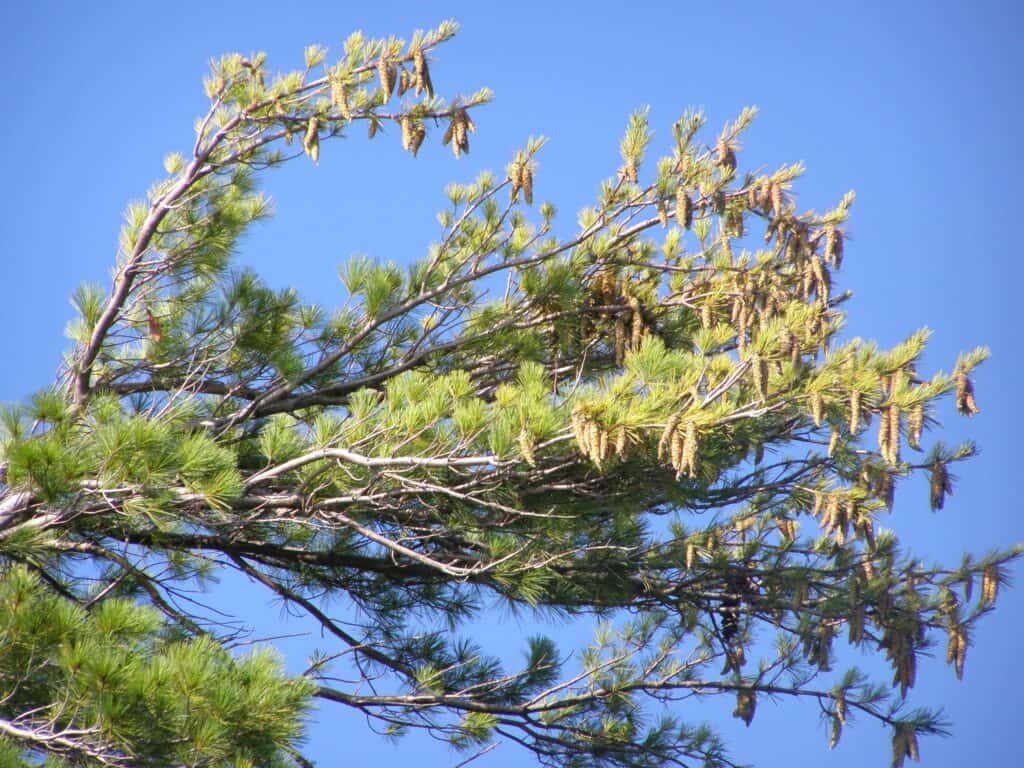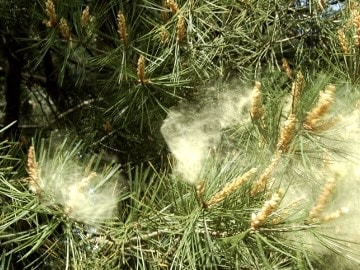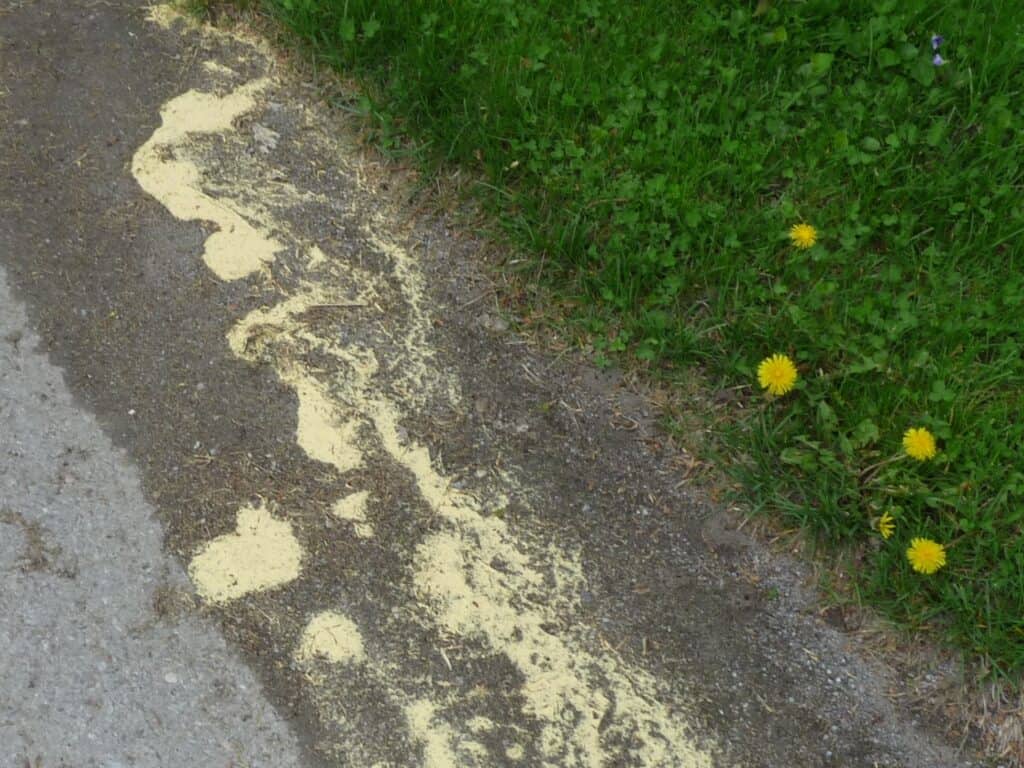Male cones are now releasing copious amounts of pollen.
Peterborough Examiner – June 2, 2023 – by Drew Monkman
In recent days, you may have noticed a mysterious dust that has descended upon your car windshield or outdoor furniture, turning surfaces a lemon colour and making puddles appear like some strange, yellow alga has bloomed. If you live on a lake, it might be the mustard-yellow scum piling up on shore that’s caught your attention.
This bizarre phenomenon is simply a manifestation of the sex lives of our coniferous trees as huge amounts of pollen are released to the wind every year in late spring. When the weather is hot and dry, you can sometimes even see what looks like a yellow cloud around pines and spruce as the wind jostles the boughs.
The source of the pollen is the abundant male cones that the trees produce. But what exactly is a cone? The term refers to the organs on conifers (pines, spruces, firs, etc.) that contain the reproductive structures. In this respect, cones are similar to flowers, although they have vastly different structures. Like many flowers, they can be either male or female. Male and female cones are found on the same tree in all conifers, with the exception of yews and junipers.
The familiar woody cone that we find on the ground under a pine or spruce is the female cone which produces seeds. The individual plates of these cones are known as scales. The male cones, which produce pollen, are soft-tissued and quickly drop from the tree. Female cones, on the other hand, are woody and can remain on the tree for long periods of time.
All conifers are wind-pollinated. Unlike wildflowers and many deciduous trees like cherries and basswoods, conifers do not rely on insects to carry pollen to the female flowers. Their cones therefore lack the bright colours, nectar rewards, or tantalizing perfumes to attract pollinators.

White pines
The white pine, Ontario’s provincial tree, is typical of many of our conifers when it comes to reproduction. In the spring, male (staminate) cones appear in clusters at the base of new shoots. They are papery, light yellow in colour, egg-shaped and measure less than a centimetre in length. They also have tightly overlapping scales. Most male cones are located high up in the tree, although some occasionally appear on lower branches.
The greenish, seed-producing female (staminate) cones also occur at the tip of new shoots. A little larger than the male cones, they are cylindrical in shape and tend to be located in the upper part of the crown. Female cones become receptive to the wind-blown pollen at precisely when the pollen grains are being released. At this time, they are very soft, and their scales are partially separated.
As pollen is carried off by the wind, some of it will inevitably come into contact with the female cones and sift down between the scales. With any luck, a grain will come to rest on one of the two ovules attached to the bottom inside of each cone scale. Each ovule contains an ovum or egg cell. Once fertilized, a seed begins to develop.
After their pollen is released, the male cones wither and fall away, often dropping from the trees like a veritable rain shower. These dry, shrivelled up male cones are a common sight anywhere pine trees occur and often cover the ground in impressive numbers.
Following pollination, the scales on the female cones grow together. A pitch-like material then seals the outside. Over the next two years, the cone gradually grows to full size (10 – 25 cm) and becomes brown in colour. In white pines, the seeds are ripe by August or September of their second summer. Reddish-brown in colour, they are about 6 mm long with a slender 15-20 cm “wing”. The seeds are released to the wind when the cone scales open up and the wing helps them glide far from the tree. The cones fall to the ground over the fall and winter. The number of cones produced can vary greatly from one year to the next and therefore have a major impact on the populations of animals that eat the seeds.
Pollen grains
The pollen grains of conifers are uniquely designed for wind pollination. First, they are extremely small, less than 1/250th of an inch (0.005 mm) in diameter. They also have two air bladders which provide buoyancy and enable them to take what amounts to a long-distance balloon ride.
When pollen grains land on a body of water, they form a temporary film but soon sink to the bottom. This, however, is not the end of the story. Pollen grains are protected by a tough outer (exine) wall which is highly resistant to decay. They essentially become microfossils that remain unchanged for thousands of years in the layers of bottom sediment. This allows paleobotanists to describe with great accuracy the history of the vegetation of an area. And, by knowing the vegetation that existed, scientists can also theorize what kind of climate there was in the past.
By examining the pollen grains found in deep peat bogs, scientists have been able to piece together the story of the changes in climate and vegetation that occurred during and since the last Ice Age. As the glaciers retreated, vegetation followed them. The pollen grains in these peat bogs show that the first trees to repopulate the land were firs and spruces. Later, pines and tamaracks came along, followed by birches and elms. Finally, oaks and maples appeared on the scene.
Allergies
Because pine pollen is relatively heavy, it is usually not breathed in as much as the lighter wind-borne pollens of birch, grasses and, in late summer, ragweed – all of which are responsible for most allergy symptoms. Also, the chemical composition of pine pollen makes it less likely to produce allergic symptoms than other types of pollen.
Take time this month to go out and closely examine the male and female cones of our many conifers. Their colour, shape, texture and location on the tree vary widely from one species to the next, but they all share a special beauty. The female cones of the tamarack – or larch – are particularly attractive. Right now, they are a deep red colour, and their scales are partially open. They almost look like scrumptious little fruits decorating the branches. Balsam fir, too, has interesting seed cones. They sit erect and cylindrical in dense groupings, almost at the top of the tree. Paying attention to conifer cones is just one more way to enjoy the changing seasons.
CLIMATE CHAOS UPDATE
4RG Meets: Heat pumps have been in the news a lot lately since they provide a very efficient means to both heat and cool our homes and reduce our carbon footprint. New advances in technology have increased their efficiency and allowed them to function in lower temperatures, such as the ones we experience in Canada and the Peterborough area. Governments are providing incentives and, in some cases, legislating their use. Looking to replace their aging natural gas furnace and air conditioner, Geoff Daw and his wife Wendy decided to convert to a cold climate air source heat pump to meet their heating and cooling requirements. After living a year with their new heat pump Geoff will share his experiences with others who might be considering making the same move. This presentation will provide information about how heat pumps work, different heat pump solutions, available government incentives, costs, and Geoff’s experiences thus far. This online presentation takes place on June 12 from 7:00 – 8:00 pm. To register, go to https://forourgrandchildren.ca/
Carbon dioxide: The atmospheric CO2 reading for the week ending May 27 was423.91 parts per million (ppm), compared to 421.31 ppm a year ago. The highest level deemed safe for the planet is 350 ppm. Rising CO2 means more climate chaos and increasingly severe storms ahead


